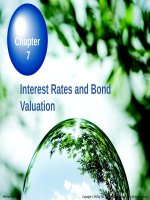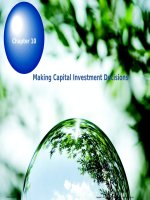Fundamentals of coroprate finance 7th ross westerfield CH17
Bạn đang xem bản rút gọn của tài liệu. Xem và tải ngay bản đầy đủ của tài liệu tại đây (233.59 KB, 29 trang )
Chapter17
•Financial Leverage and
Capital Structure Policy
McGraw-Hill/Irwin
Copyright © by The McGraw-Hill Companies, Inc. All rights
Chapter 17 – Index of Sample
Problems
•
•
•
•
•
•
Slide # 02 - 03
Slide # 04 - 11
Slide # 12 - 13
Slide # 14 - 15
Slide # 16 - 21
Slide # 22 - 27
Break-even EBIT
Homemade leverage
M&M Proposition I, no tax
M&M Proposition II, no tax
M&M Proposition I with tax
M&M Proposition II with tax
2: Break-even EBIT
You are considering two different capital structures. The first option
consists of 20,000 shares of stock. The second option consists of
10,000 shares of stock plus $200,000 of debt with an interest rate of
8%. Ignore taxes.
What is the break-even level of EBIT between these two options?
3: Break-even EBIT
EPS U = EPSL
EBIT EBIT − ($200,000 × .08)
=
20,000
10,000
10,000EBIT = 20,000EBIT − 20,000($16,000)
10,000EBIT = 320,000,000
EBIT = $32,000
4: Homemade leverage
ABCO, Inc. has EBIT of $100,000. There are 50,000 shares of stock
outstanding at a market price of $20 a share. ABCO has just decided to
issue $400,000 of debt at a rate of 8% to repurchase shares of stock.
Fred owns 20,000 shares of ABCO stock. Fred wants to use homemade
leverage to offset the leverage being assumed by ABCO.
How many shares of ABCO stock must Fred sell to achieve his goal if
he loans out the funds from the stock sale at 8% interest?
5: Homemade leverage
EBIT
Interest
Net income
# of shares
EPS
No Debt
$100,000
0
$100,000
50,000
$2.00
Debt
$100,000
?
?
?
?
6: Homemade leverage
Interest = $400,000 × .08 = $32,000
$400,000
Shares repurchased =
= 20,000 shares
$20
Shares outstanding with debt = 50,000 - 20,000 = 30,000
7: Homemade leverage
EBIT
Interest
Net income
# of shares
EPS
No Debt
$100,000
0
$100,000
50,000
$2.00
Debt
$100,000
32,000
$ 68,000
30,000
$2.2667
8: Homemade leverage
Unlevered:
20,000 shares × $2.00
= $40,000
Levered:
20,000 shares × $2.2667
= $45,334
9: Homemade leverage
Stock: 30,000 × $20
= $ 600,000
Weights
60%
Debt:
= $ 400,000
40%
Total:
$1,000,000
100%
10: Homemade leverage
Investment = 20,000 × $20 = $400,000
Stock:
60% of $400,000 = $240,000
$240,000 ÷ $20 = 12,000 shares
Loan out:
40% of $400,000 = $160,000
11: Homemade leverage
No company debt and no homemade leverage:
20,000 shares × $2.00
= $40,000
Homemade leverage used to offset firm leverage:
Stock: 12,000 × $2.2667
= $27,200
Loan: $400,000 × .08
= $12,800
Total:
$40,000
12: M&M Proposition I, no tax
A debt-free firm currently has 400,000 shares of stock outstanding. The
company is considering reducing the number of shares to 300,000. To
do this, the firm will have to borrow $5 million at 8% interest.
Ignoring taxes, what is the value of the firm?
13: M&M Proposition I, no tax
$5 million
Price per share =
400,000 - 300,000
$5 million
=
100,000
= $50
VL = VU
(300,000 × $50) + $5,000,000 = 400,000 × $50
$15,000,000 + $5,000,000 = $20,000,000
$20,000,000 = $20,000,000
14: M&M Proposition II, no tax
Walter’s Store has a debt/equity ratio of .60. The required return on
assets is 12% and the pre-tax cost of debt is 8%. Ignore taxes.
What is the cost of equity?
15: M&M Proposition II, no tax
R E = R A + (R A − R D ) × D E
= .12 + (.12 − .08) × .60
= .12 + .024
= .144
= 14.4%
16: M&M Proposition I with tax
The Bigely Co. has $5,000 worth of debt outstanding that is selling at
par. The coupon rate is 9% and the company tax rate is 34%.
What is the amount of the annual tax shield?
What is the present value of the tax shield?
17: M&M Proposition I with tax
Annual tax shield = $5,000 × .09 × .34
= $153
Pr esent value of tax shield = TC × D
= .34 × $5,000
= $1,700
18: M&M Proposition I with tax
Dawn, Inc. has 150,000 shares of stock outstanding at a market price of
$30 a share. The cost of equity is 10%. The company is considering
adding $1.5 million of debt with a coupon rate of 7%. The debt will sell
at par. The tax rate is 35%.
What will the value of Dawn, Inc. be after they add the debt to their
capital structure?
What is the levered value of the equity?
19: M&M Proposition I with tax
VL = VU + (TC × D)
= (150,000 × $30) + (.35 × $1,500,000)
= $4,500,000 + $525,000
= $5,025,000
VD = $1.5 million
VE = VL − VD
= $5,025,000 − $1,500,000
= $3,525,000
20: M&M Proposition I with tax
The Baker Co. has an unlevered cost of capital of 12% and a tax rate of
35%. The expected EBIT is $1,200. The company has $3,000 of debt
which is selling at par. The coupon rate is 8%.
What is the value of the firm?
21: M&M Proposition I with tax
EBIT × (1 − TC )
VU =
RU
$1,200 × (1 − .35)
=
.12
= $6,500
VL = VU + (TC × D)
= $6,500 + (.35 × $3,000)
= $6,500 + $1,050
= $7,550
22: M&M Proposition II with tax
Charlie & Co. has $2,500 in bonds outstanding that are selling at par.
The bonds have a 7% coupon rate and pay interest annually. The
expected EBIT is $1,400 and the unlevered cost of capital is 10%. The
tax rate is 35%.
What is the cost of equity?
23: M&M Proposition II with tax
R E = R U + (R U − R D ) × (D ÷ E) × (1 − TC )
= .10 + (.10 − .07) × ($2,500 ÷ E) × (1 − .35)
24: M&M Proposition II with tax
EBIT × (1 − TC )
VU =
RU
$1,400 × (1 − .35)
=
.10
= $9,100
VL = VU + TC × D
= $9,100 + (.35 × $2,500)
= $9,975
VL − VD = VE
$9,975 − $2,500 = $7,475









